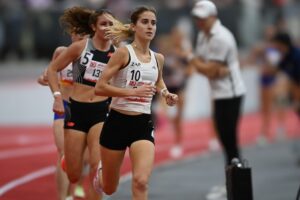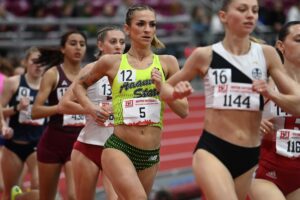
Not many athletes voluntarily passed up the opportunity to run at last month’s U.S. Olympic Marathon Trials, but Zoe Baker was one of them. Baker, 23, a graduate student at Colorado School of Mines, wanted to make the most of her last two seasons in the NCAA, chasing goals at shorter distances alongside her teammates, so she opted to run indoor and outdoor track instead.
Because of a combination of redshirting and the pandemic, Baker is in her sixth year of NCAA eligibility. She didn’t have cross country eligibility last fall, so she made her marathon debut at Bakline’s McKirdy Micro Marathon, where she ran 2:35:52 and earned a spot at the Trials. Skipping the Trials wasn’t an easy choice, but she’s planning to go all-in on the marathon after graduation.
Making her marathon debut
It’s rare for NCAA distance runners to run marathons, but Baker thinks it’s likely to be her best distance, and she had wanted to run one for years. Her coach, Chris Siemers, an Olympic Marathon Trials qualifier himself, was supportive of her goal and wrote all of her training. Baker did part of her buildup in the Bay Area, where she was doing a co-op at a software engineering company. She did a lot of her California training alone, but she also found some locals to join her. “I’m always on Strava or Instagram, trying to find women I can run with,” she told Fast Women. “I love running with people. I will absolutely yap someone’s ear off during a run.”
Her volume peaked at just over 90 miles per week, and she documented some of her training in a humorous manner, on TikTok. Her parents, who live in Colorado, flew in for the race, which took place in Valley Cottage, New York, north of New York City.
In training, Baker practiced taking a gel every three miles, and having a strong stomach, she figured fueling well would be her superpower. But in retrospect, she thinks she overdid her pre-race fueling. “I felt like I left the Thanksgiving dinner table and started running,” she said.
When it was time to take her first gel, she couldn’t. “I was like, ‘I don’t know what’s going to happen if I don’t take this gel, but I do know what’s going to happen if I do take it. And puking right now seems like the worst option of those two.’” But she reassured herself that she was burning fuel quickly and by mile six, she was able to start taking gels.
Baker focused on relaxing, and she chatted with some of the other runners in the pack here and there. The pace felt easy and the conditions were great. She was starting to feel a bit antsy, thinking about the fact that Siemers had told her that if she felt good, she should make it a race with 10K to go. But right around the 20-mile mark, she got clipped by another runner and fell hard. With everyone trying to stay on the tangent line painted on the course, it was difficult to avoid being in other people’s space.
But Baker popped up and took off after the pack. She glanced at her watch and noticed that thanks to the adrenaline, she was running 5:15 pace, so she backed off. She reeled the pack back in, ran with them briefly, and then decided to keep her momentum going and pulled away. The closing miles hurt, but she got progressively faster and crossed the finish line with blood streaming down her legs, from the fall.
Even with the bloody knees, Baker had a fantastic experience in her marathon debut. Recovery was a little tougher than she anticipated. Though she’s not normally very good about taking time off, the marathon forced her to. And by February, she ran 16:12.55 in the indoor 5,000m.
From JV runner to All-American
Baker grew up in Longmont, Colorado, minutes away from where members of the On Athletics Club now train. “You can’t get any of the (Strava) segments near my house,” she said.
Her mother is a good athlete—she played basketball for her college in China, and once she came to the U.S., she added volleyball, indoor soccer, competitive skiing, and Olympic weightlifting, among other things. Baker says her mom tried to get her into “contact sports and entertaining team sports,” but she didn’t have the coordination. She thinks it was her dad who sparked her interest in running, because sometimes they’d go on short trail runs together.
Baker skied, played soccer in middle school, and started running track in eighth grade. She wasn’t bad, but her times didn’t scream future All-American. She remained on her school’s JV team through sophomore year, and didn’t break 6:00 in the mile or 20:00 in the 5K until her junior year. It didn’t occur to her to train during the summer or on the weekends.
She began high school at Boulder’s Fairview High School, so she could do an International Baccalaureate program, but she wasn’t prepared for the academic load. During her sophomore year, her academic and social anxiety grew strong enough that she was unable to attend school. She transferred to an online school that spring. Baker had to miss the track season, which made her realize how much she enjoyed being on a team. She began to run consistently on her own.
For her junior year, she returned to in-person school, switching to Silver Creek High School, closer to her home. And with a summer of training behind her, she had a breakthrough year. In October of her senior year, when she signed with Mines, she was still blown away by the fact that she was good enough to run in college. At the time, she had run only 5:35 for 1600m and 11:47 for 3200m.
Baker improved significantly her senior year of high school, lowering her 1600m to 5:15, her 3200m to 11:14 and her 5K to 18:25. It didn’t take her long to become the number one runner at Mines. But during her six years of college, the level of competition in DII has increased significantly, as has the talent on her team. It’s not easy to recruit women to a school that offers only engineering majors, and nearly 70 percent of the student body is male. But Siemers relies heavily on developing the talent he gets, and he’s done a good job of it. Baker now has six or seven other women pushing her in practice.
A nine-time DII All-American, Baker has personal bests of 9:33.05 for 3,000m, 16:07.72 for 5,000m, and 33:52.75 for 10,000m. She thinks the biggest factor in her improvement is her durability. She estimates she ran 20 miles per week at the beginning of high school, now she’s able to handle 70–80 miles per week during the track season, and more during marathon training. Strength training has helped her stay healthy, and she also chalks some of it up to luck.
She used to go too hard in workouts. “Now I’ve learned that the best way to train is apparently not redlining every single time you do anything,” she said.
She’s also very in tune with her body and when she feels an injury coming on, she knows she needs to eat more and train less right away. Baker says she underfueled during high school and was amenorrheic for roughly two years, but she began eating more in college and her period came back. “I was like, ‘Do you want to break? Or do you want to not break and get better?’” she said.
The horror stories about college teams and eating disorders make the rounds, and Baker says she has heard them, but she describes her team as the healthiest group of women she has ever met. “The team culture is incredible,” she said. “There are just a lot of positive role models in every single aspect—fueling yourself, taking your training seriously, getting cool internships, and getting cool engineering jobs. It’s the team environment that my high school self needed.”
Moving forward
Baker has also excelled academically at Mines. In 2022, she graduated with a double degree in computational and applied math and computer science, and now she’s earning a master’s degree in computer science. She has won the NCAA’s Elite 90 award, which goes to the athlete with the highest GPA at each NCAA championship, four times. And in 2022, she was named an NCAA Woman of the Year finalist.
Baker is still figuring out where her career will take her, but she has already made some post-collegiate racing plans. After the track season, she plans to run the Garry Bjorklund Half Marathon in Duluth, Minnesota, in June. And she has signed up to run the Chicago Marathon in October. Siemers has raised the idea of trying to break 2:30. “That sounds very aggressive,” she said. “We’ll see how training goes.”
But first, she has an outdoor track season to run, and she would like to lower her 5,000m personal best before she’s done in the NCAA. Her first opportunity to give it a shot will be at the Bryan Clay Invitational on April 12. “I’ve been flirting with the 16-minute barrier for too long and I just want to break it,” she said. “I feel like I’m in the shape to do it, I just need things to go right. It would be so amazing to break it honestly for no other reason than I think 15-something sounds super fricking cool.”





